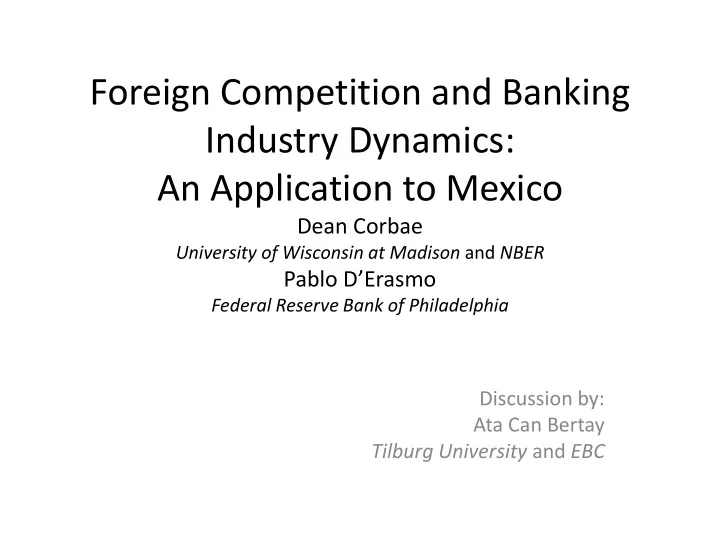

Foreign Competition and Banking Industry Dynamics: An Application to Mexico Dean Corbae University of Wisconsin at Madison and NBER Pablo D’Erasmo Federal Reserve Bank of Philadelphia Discussion by: Ata Can Bertay Tilburg University and EBC
Overview • Summary • The case of Mexico: Background • Discussion of results: – Global vs. Local crisis – Higher Competition vs. Foreign Competition – Local vs. Global shocks • Policy discussion • Conclusion
Summary • A general equilibrium framework • The effects of foreign competition on banking industry dynamics and welfare in Mexican case • Welfare gains both for households and entrepreneurs • The effect of competition per se is large • Domestic economy may import a global crisis • Both national and foreign banks behave strategically
The Case of Mexico • Two experiments: – Privatization (1991-1995) – Foreign bank ownership (from 1995 onward) • Government=>Private=>Foreign • Funding government=> Credit expansion and bailout (crisis)=>prudent behavior
Global vs. Local crisis • Is it just exogenous productivity shocks or something else driving the dynamics so that the output difference between benchmark and no foreign competition case gets larger in global crisis (and double crisis) and smaller in local crisis? • Don’t we expect the opposite? (internal capital market literature) – In local crisis foreign banks may keep the credit flowing (thanks to the access to parent funding) – In global crisis they may retrench (for example, to provide funds to the parent banks)
Foreign monopoly Domestic monopoly
Foreign monopoly Domestic monopoly
How large are the differences quantitatively? • Higher Competition vs. Foreign Competition
How large are the differences quantitatively? • Local shocks vs. “imported” global shocks Local shock Global shock
Other issues • Policy discussion: Missing dimensions – Institutions and Regulation • The role of heterogeneity (Beck et al., 2013) • Privatization without institutional and regulatory reform=> Related lending/tunneling (Haber 2005) • Foreign banking without contract enforcement=>less credit to firms and households (Haber 2005) – Government as an agent (owner and borrower) – Type of foreign entry: De novo vs. M&A – Welfare implications of foreign banks in Mexico • Lower outreach (Beck and Martinez Peria, 2010) • No increase in credit availability (Haber and Musacchio, 2010) • Minor issues – Typos – A few suggestions regarding the presentation
Conclusion • Very useful tool to analyze the effects of competition and foreign entry in an emerging market environment • Both competition and foreign presence are important • Curious about how this analysis would differ in alternative contexts • Someone should be cautious especially regarding welfare analysis as some crucial elements regarding emerging market environment missing • Better background for Mexico will help a lot for intuition and interpretation
Extra: No bailout assumption • No foreign competition=>No exit=>No tax for deposit insurance • Mid- 90’s no foreign banks but reckless banking by domestic banks=>large bailouts at the expense of taxpayers
Recommend
More recommend